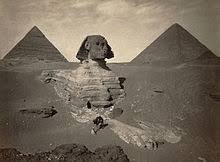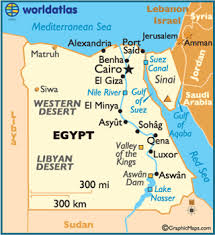Week 12!! Egypt
Egypt: the Ancient and the Modern
Wow, it's already week 12!! We're a quarter of the way through our journey and still going strong :) I took an extra day off this week to celebrate my anniversary in LA so today's post is a little late. Sorry. In honor of the upcoming holiday (Halloween), I thought we would do some countries with a little spook in them. Egypt might not come to your mind first but there are many creepy things to learn about - mummies, scarab beetles, and tombs to name a few.
 Egypt is a country where the ancient culture and the modern culture are very intermingled. You might just as easily see people in jeans and a t-shirt listening to their ipod as you would men wearing galabayya, the traditional long cotton robe. Many of the women the traditional garb of Islam in public but at home are wearing the latest fashions. The ancient culture of Pharaohs and gods is what draws the tourists and that is what they give you - at souvenir shops and marketplaces. Tourism is big in Egypt and they should be very proud of their past - it was AMAZING!
Egypt is a country where the ancient culture and the modern culture are very intermingled. You might just as easily see people in jeans and a t-shirt listening to their ipod as you would men wearing galabayya, the traditional long cotton robe. Many of the women the traditional garb of Islam in public but at home are wearing the latest fashions. The ancient culture of Pharaohs and gods is what draws the tourists and that is what they give you - at souvenir shops and marketplaces. Tourism is big in Egypt and they should be very proud of their past - it was AMAZING!
 Who hasn't seen a picture of the Great Pyramids? or the Sphinx? I don't think many people. Egypt has one of the oldest and most impressive cultures of any country, with more than a 51,000 year and 6000 years of recorded history there is much to learn about. The Egyptians were the first to have a government and, because they also had one of the first written languages, they were the first to invent paper- papyrus made from the reeds growing along the Nile. They built huge tombs and temples for their kings and gods, real architectural accomplishments considering what they had to work with.
Who hasn't seen a picture of the Great Pyramids? or the Sphinx? I don't think many people. Egypt has one of the oldest and most impressive cultures of any country, with more than a 51,000 year and 6000 years of recorded history there is much to learn about. The Egyptians were the first to have a government and, because they also had one of the first written languages, they were the first to invent paper- papyrus made from the reeds growing along the Nile. They built huge tombs and temples for their kings and gods, real architectural accomplishments considering what they had to work with.
 But can all of you find Egypt on a map? Did you know it was on 2 continents? It is. Egypt is a transcontinental country - big word. Most of the country is in Northeastern Africa but a small land bridge, called the Isthmus of Suez, connects it with the Asian continent, the Gaza Strip and Israel. Pretty cool, I thought so anyway. The Isthmus of Suez is also where the the Suez canal was built which makes it much easier for the boats and ships to get from the Mediterranean Sea to the Red Sea. You can find the capital city of Cairo located at the latitude and longitude of 30.05ºN / 31.22ºE. As is the case with most of the major cities, it is located alongside the Nile River. Actually 99% of the population of Egypt lives near the Nile River, the rest of the country is desert and has VERY LITTLE rainfall. The Nile was and is the lifeblood of Egypt. Before the Aswan Dam was built, it flooded regularly and this flooding replenished the soil and made them fertile and rich. The people travelled on the river and shipped their goods along it. Camels were also used but I know I'd much rather float down a river then ride a hot, stinky camel all day. Today, the camels are used in Camel races and for the tourist industry, but the Nile is still used much as it was back in the ancient days (only with more modern boats).
The politics of Egypt are a topic all on their own. The country has been in wars, political upheavals, and unrest many, many times over the centuries and even in recent times. But this blog is for family fun, so let's leave all that elsewhere and learn a little about the good old days of Ancient Egypt....
But can all of you find Egypt on a map? Did you know it was on 2 continents? It is. Egypt is a transcontinental country - big word. Most of the country is in Northeastern Africa but a small land bridge, called the Isthmus of Suez, connects it with the Asian continent, the Gaza Strip and Israel. Pretty cool, I thought so anyway. The Isthmus of Suez is also where the the Suez canal was built which makes it much easier for the boats and ships to get from the Mediterranean Sea to the Red Sea. You can find the capital city of Cairo located at the latitude and longitude of 30.05ºN / 31.22ºE. As is the case with most of the major cities, it is located alongside the Nile River. Actually 99% of the population of Egypt lives near the Nile River, the rest of the country is desert and has VERY LITTLE rainfall. The Nile was and is the lifeblood of Egypt. Before the Aswan Dam was built, it flooded regularly and this flooding replenished the soil and made them fertile and rich. The people travelled on the river and shipped their goods along it. Camels were also used but I know I'd much rather float down a river then ride a hot, stinky camel all day. Today, the camels are used in Camel races and for the tourist industry, but the Nile is still used much as it was back in the ancient days (only with more modern boats).
The politics of Egypt are a topic all on their own. The country has been in wars, political upheavals, and unrest many, many times over the centuries and even in recent times. But this blog is for family fun, so let's leave all that elsewhere and learn a little about the good old days of Ancient Egypt....
No comments:
Post a Comment